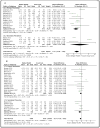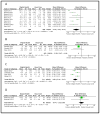Digital health interventions for the prevention of cardiovascular disease: a systematic review and meta-analysis
- PMID: 25841251
- PMCID: PMC4551455
- DOI: 10.1016/j.mayocp.2014.12.026
Digital health interventions for the prevention of cardiovascular disease: a systematic review and meta-analysis
Abstract
Objective: To assess the potential benefit of digital health interventions (DHIs) on cardiovascular disease (CVD) outcomes (CVD events, all-cause mortality, hospitalizations) and risk factors compared with non-DHIs.
Patients and methods: We conducted a systematic search of PubMed, MEDLINE, EMBASE, Web of Science, Ovid, CINHAL, ERIC, PsychINFO, Cochrane, and Cochrane Central Register of Controlled Trials for articles published from January 1, 1990, through January 21, 2014. Included studies examined any element of DHI (telemedicine, Web-based strategies, e-mail, mobile phones, mobile applications, text messaging, and monitoring sensors) and CVD outcomes or risk factors. Two reviewers independently evaluated study quality utilizing a modified version of the Cochrane Collaboration risk assessment tool. Authors extracted CVD outcomes and risk factors for CVD such as weight, body mass index, blood pressure, and lipid levels from 51 full-text articles that met validity and inclusion criteria.
Results: Digital health interventions significantly reduced CVD outcomes (relative risk, 0.61; 95% CI, 0.46-0.80; P<.001; I(2)=22%). Concomitant reductions in weight (-2.77 lb [95% CI, -4.49 to -1.05 lb]; P<.002; I(2)=97%) and body mass index (-0.17 kg/m(2) [95% CI, -0.32 kg/m(2) to -0.01 kg/m(2)]; P=.03; I(2)=97%) but not blood pressure (-1.18 mm Hg [95% CI, -2.93 mm Hg to 0.57 mm Hg]; P=.19; I(2)=100%) were found in these DHI trials compared with usual care. In the 6 studies reporting Framingham risk score, 10-year risk percentages were also significantly improved (-1.24%; 95% CI, -1.73% to -0.76%; P<.001; I(2)=94%). Results were limited by heterogeneity not fully explained by study population (primary or secondary prevention) or DHI modality.
Conclusion: Overall, these aggregations of data provide evidence that DHIs can reduce CVD outcomes and have a positive impact on risk factors for CVD.
Copyright © 2015 Mayo Foundation for Medical Education and Research. Published by Elsevier Inc. All rights reserved.
Conflict of interest statement
All authors contributed to the work, and have no conflicts of interest to disclose.
Figures




References
-
- Roger V, Go AS, Lloyd-Jones DM, Benjamin EJ, Berry JD, Borden WB, Bravata DM, Dai S, Ford ES, Fox CS, Fullerton HJ, Gillespie C, Hailpern SM, Heit JA, Howard VJ, Kissela BM, Kittner SJ, Lackland DT, Lichtman JH, Lisabeth LD, Makuc DM, Marcus GM, Marelli A, Matchar DB, Moy CS, Mozaffarian D, Mussolino ME, Nichol G, Paynter NP, Soliman EZ, Sorlie PD, Sotoodehnia N, Turan TN, Virani SS, Wong ND, Woo D, Turner MB American Heart Association Statistics Committee and Stroke Statistics Subcommittee. Executive summary: heart disease and stroke statistics--2012 update: a report from the American Heart Association. Circulation. 2012;125:188–197. - PubMed
-
- Rosamond W, Flegal K, Furie K, Go A, Greenlund K, Haase N, Hailpern SM, Ho M, Howard V, Kissela B, Kittner S, Lloyd-Jones D, McDermott M, Meigs J, Moy C, Nichol G, O’Donnell C, Roger V, Sorlie P, Steinberger J, Thom T, Wilson M, Hong Y American Heart Association Statistics Committee and Stroke Statistics. Heart disease and stroke statistics—2008 update: a report from the American Heart Association Statistics Committee and Stroke Statistics Subcommittee, Circulation. Circulation. 2008;117:e25–e146. - PubMed
-
- Yusef S, Hawkins S, Ounpus S, Dans T, Avezum A, Lanas F, McQueen M, Budaj A, Pais P, Varigos J, Lisheng L. Effects of potentially modifiable risk factors associated with myocardial infarction in 52 countries (the INTERHEART study): case controlled study. Lancet. 2004;342:937– 952. - PubMed
-
- Go A, Mozaffarian D, Roger VL, Benjamin EJ, Berry JD, Borden WB, Bravata DM, Dai S, Ford ES, Fox CS, Franco S, Fullerton HJ, Gillespie C, Hailpern SM, Heit JA, Howard VJ, Huffman MD, Kissela BM, Kittner SJ, Lackland DT, Lichtman JH, Lisabeth LD, Magid D, Marcus GM, Marelli A, Matchar DB, McGuire DK, Mohler ER, Moy CS, Mussolino ME, Nichol G, Paynter NP, Schreiner PJ, Sorlie PD, Stein J, Turan TN, Virani SS, Wong ND, Woo D, Turner MB American Heart Association Statistics Committee and Stroke Statistics Subcommittee. Executive summary: heart disease and stroke statistics--2013 update: a report from the American Heart Association. Circulation. 2013;127:143–152. - PubMed
-
- Pfuntner A, Wier LM, Steiner C. HCUP Statistical Brief #146. Agency for Healthcare Research and Quality; Rockville, MD: Jan, 2013. Costs for Hospital Stays in the United States, 2010. - PubMed
Publication types
MeSH terms
Grants and funding
LinkOut - more resources
Full Text Sources
Other Literature Sources
Medical
Miscellaneous

